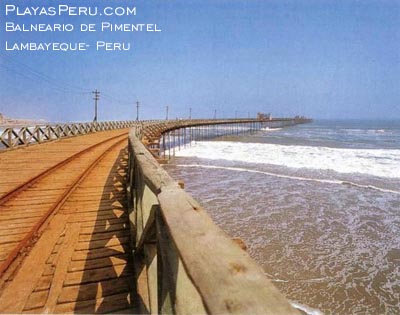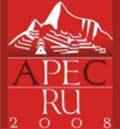United Kingdom
| Welcome |
| Peru in Brief |
| History |
| Geography |
| Government & Politics |
| Maritime delimitation between Peru and Chile |
| News |
Links |
| LAMBAYEQUE | |||
 |
|||
| Pimentel Beach | |||
| Capital: | Chiclayo | ||
| Elevation: |
16 m | ||
| Climate: |
Warm throughout most of the year: December-March 34°C, April-June 20°C, July-August 14°C, September-December 23°C. |
||
| History: |
Prior to 1562, Chiclayo had not appeared among the chieftainships of Lambayeque. Between 1563 and 1566 it is referred to as a resettlement centre for Indians from Cinto and Collique. Current evidence suggests that Chiclayo was not founded as a Spanish town, but grew as a reduccion de indios facilitating the collection of native tributes and the missionaries' evangelising task. |
||
| Among the peoples who inhabited these lands, the Mochica had words resembling " Chiclayo ": Chiclayap or Chekliayok apparently meant "a place with green branches". Writing in 1664, Father Fernando de la Carrera referred to the town as "Chiclaiep". |
|||
| Lambayeque was declared independent by Pascual Saco Oliveros and other patriots attending the town council on December 30, 1820 . | |||
| Places of Interest: | Church of Santa Veronica. Built in 1940, it was destroyed on three successive occasions by earthquakes hitting Chiclayo . |
||
Teatro Dos de Mayo. Built in 1890. |
|||
Cathedral of Chiclayo. Built in 1869: a spacious, well-proportioned church with round arches, columns and domes. |
|||
House of Elias Aguirre. A historic monument on account of its being the birthplace of the local hero Elias Aguirre . |
|||
Monsefu. The town noted for its flowers lies 12 km from Chiclayo . Craft products include straw, reed and shrub-fibre weavings, embroideries, woodwork, thread decorations, cotton fabrics. |
|||
Beaches at Pimentel, Santa Rosa (Caleta de Pescadores) and Puerto Eten. |
|||
Cerro Mulato Petroglyphs. Pre-Columbian engravings on the rocks of Cerro Mulato (60 km from Chiclayo ) present intriguing geometric designs. |
|||
Huaca Rajada. In 1987, the tomb of a high-ranking member of the Mochica people and his following was discovered intact at Sipan, a village within the Pomaica sugar estate 33 km south of Chiclayo . Invaluable gold pieces and other pre-Columbian objects found there have toured the world and have been hailed as the 20 th century's greatest single archaeological find. |
|||
Bruning Museum. The golden vault containing the material from the tomb of the "Lord of Sipan" is preserved here. The museum also features a four-tiered exhibit illustrating the cultures of ancient Peru. |
|||
The Condor de Oyotun. Near the turn-off for Zana on the Pan-American highway (Km 733) is this giant ground drawing, 60 m long and as many wide, thought to be 1,000 years old. |
|||
Zana. Ruins from pre-colonial and colonial times, including four convents, 46 km from Chiclayo. |
|||
| <BACK> | |||





